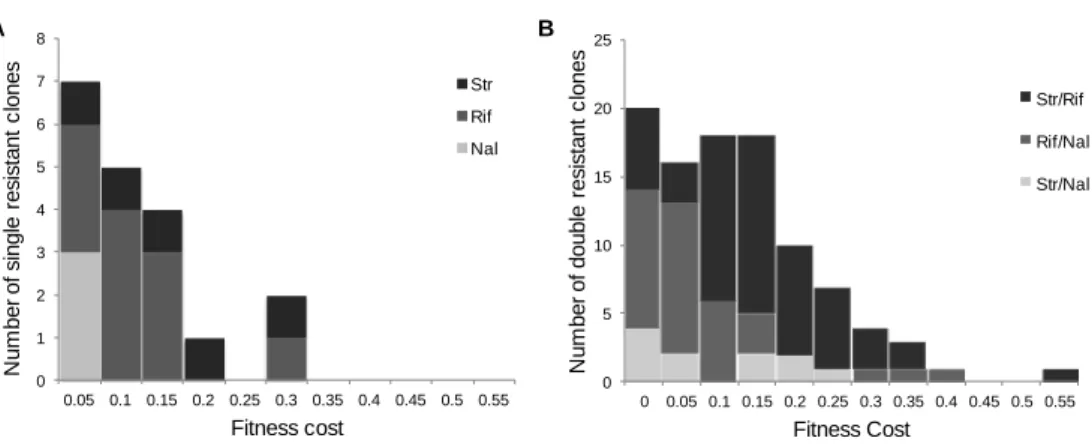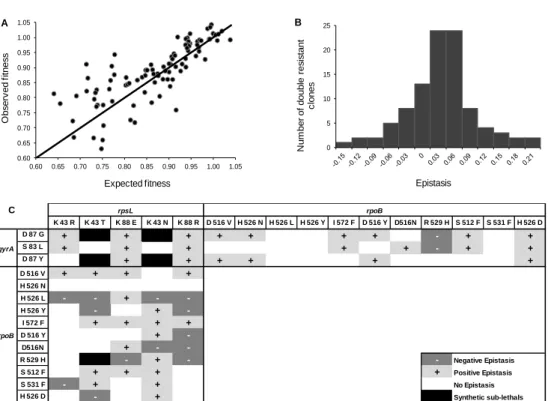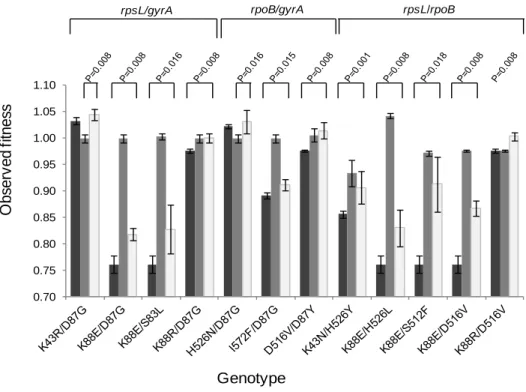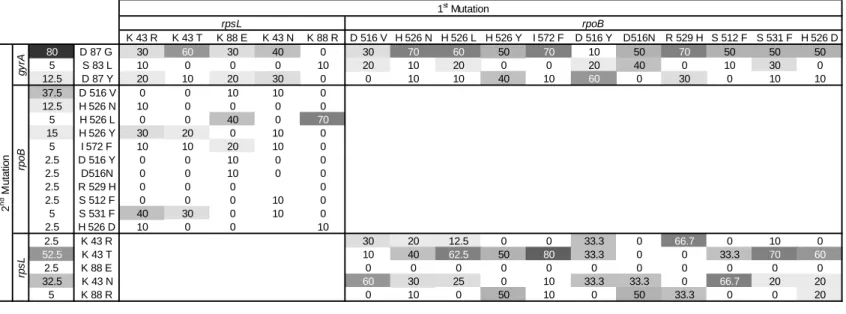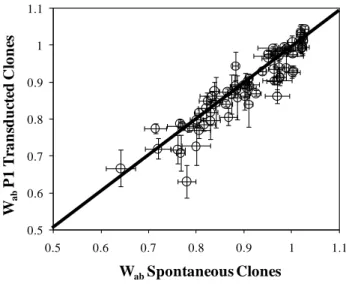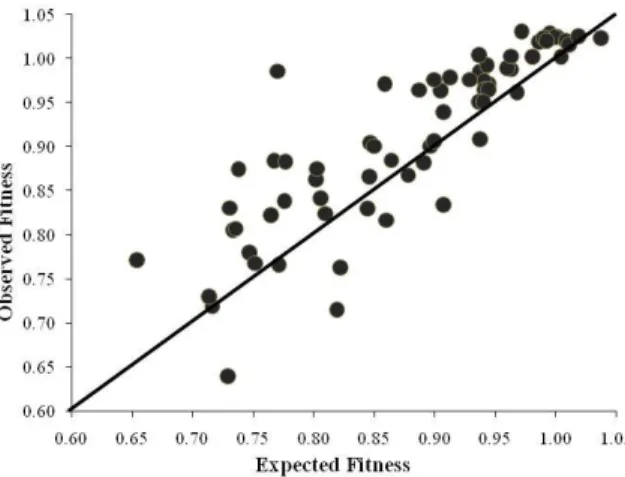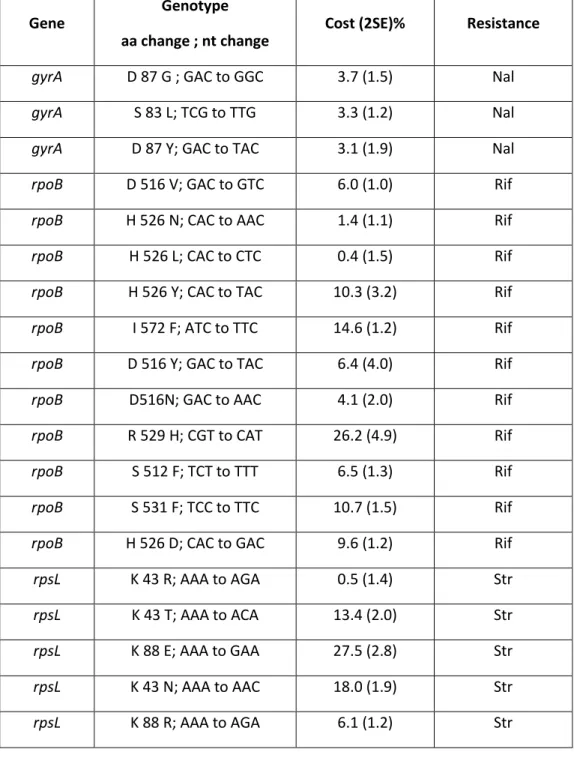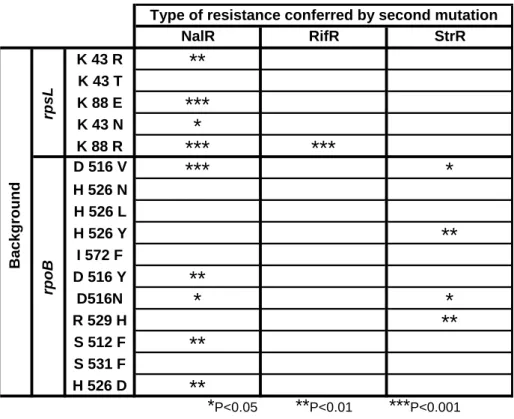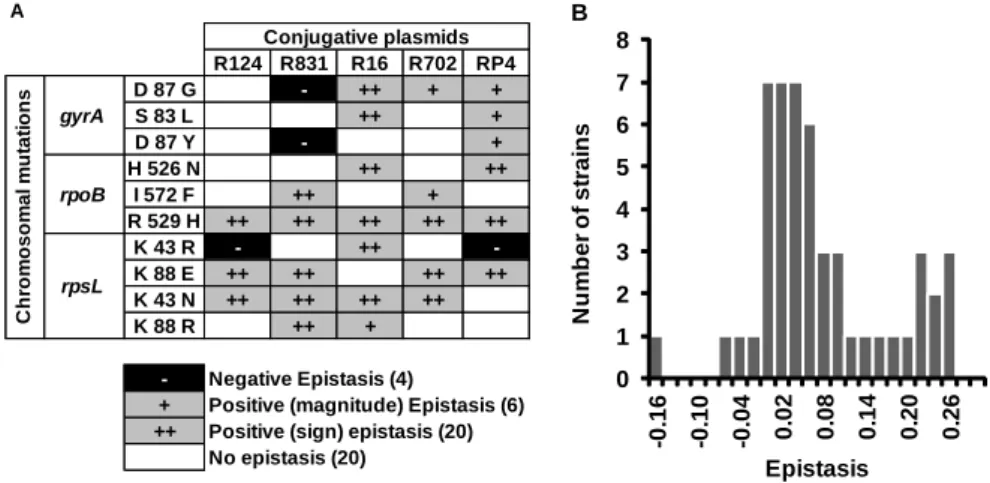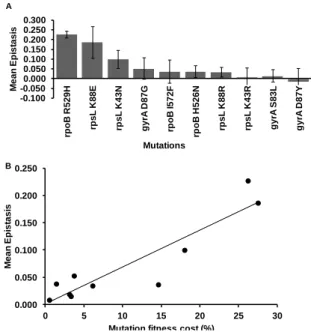EPISTASIS AND DRUG RESISTANCE
i
U
NIVERSIDADE DE
L
ISBOA
F
ACULDADE DE
C
IÊNCIAS
D
EPARTAMENTO DE
B
IOLOGIA
V
EGETAL
THE IMPACT OF GENETIC INTERACTIONS IN
ANTIBIOTIC RESISTANCE
Sandra Isabel Gonçalves Trindade
Dissertação para obtenção do grau de Doutor orientada por:
Doutora Isabel Gordo, Instituto Gulbenkian de Ciência
Professor Doutor Francisco Dionísio, Faculdade de Ciências da
Universidade de Lisboa
D
OUTORAMENTO EM
B
IOLOGIA
(G
ENÉTICA
)
iii
ACKNOWLEDGEMENTS
There are some people without whom this thesis would not be possible.
First I would like to thank my supervisor Isabel Gordo. She believed in me when few did. For me, she is a great example as scientist and she has supported me a lot, helping me growing as a scientist. Thank you for all that you have been giving me, the researcher I am today I own it to you. Second, but not less important, I am thankful to my supervisor Francisco Dionísio. You have made my dream possible by believe in me and in my capabilities. Thank you so much for all the advice, scientific discussions and hard words that made me grow as scientist. I learned much from both of you and I am grateful for that.
To all the members of my group (past and present members), the Evolutionary Biology group: an enormous thank you for all the conversations and support across these years. You were a very important part of my life during my PhD: with you guys I celebrated victories and overcome disappointments. It would not be the same without you all.
To my other group, Evolutionary Ecology of Microorganisms, especially Rui Silva and Sílvia Mendonça; it was very pleasant and enriching to work with you.
I also thank the IGC for hosting me and made me feel at home as well as for the amazing scientific environment and the Fundação para a Ciência e Tecnologia for their financial support with the grant SFRH / BD / 40162 / 2007.
iv
There are other important people without whom this thesis would not be the same and to whom I must thank:
- Karina Xavier for the enthusiasm and discussions about my work.
- Miguel Godinho for everything you teach me about the DNA machinery, the ideas about my work and results and for the nice encouraging words.
- To the ―group next door‖, the bacterial signaling group, for the delightful discussions, for the contagious good mood and for sharing the joys and sorrows.
- To my dear friends that were always there for me. Thank you for hearing all my complaints and celebrate with me all my victories. A special thank to Maggie which followed closely this journey, always with a word of comfort when necessary. Margarida, my companion of nonsense, thank you for all the afternoons talking about nothing and everything that helped me to abstract from all the annoying lab results over these years. Teresinha, a special thank for helping me format this document.
- Rui, thank you so much for bringing to my life that extra piece of mind I needed for the last step of this journey. Thank you for embrace me and make me feel that nothing can go wrong.
And the last, but certainly not the least, a very special thank to my family: my dear parents and brother I would never have words to express how grateful and honored I am to be your daughter and sister. You are my floor and my fortress every day of my life but especially on stormy days. Thank you for believe in me no matter what and for the unconditional support.
v
Para o meu querido avô que quis e acreditou tanto como eu.vii
SUMMARY
Genetic interactions, both between genetic material and between this and the surrounding environment of a given individual are important factors for understanding the process of evolution of natural populations. The study of this interactions as well as their integration in evolutionary terms may have several applications such as, for example, understanding the observed prevalence of antibiotic resistance in natural populations. In this thesis the patterns of genetic interactions between multiple-resistances to antibiotics were explored. In particular, epistasis and genotype-by-environment interactions operating among antibiotic resistances were studied.
To measure levels of epistasis occurring between multiple-antibiotic-resistances in the complete absence of antibiotics, mutants resistant to three antibiotics commonly used in clinic were first generated: nalidixic acid, rifampicin and streptomycin. With these mutants double resistant mutants were created. By measuring the costs of each mutation individually and jointly the type of epistasis operating between different sets of resistance mutations was determined. The cost of double resistance was majorly lower than expected, revealing the presence of positive epistasis between mutations conferring resistance to the studied antibiotics. The same patterns were observed for interactions between a set of resistance mutations and conjugative plasmids with multiple-resistance factors. However, in this case, extreme cases of positive epistasis coined sign epistasis were observed for a large fraction of combinations. This type of interactions was also observed in the previous study yet less frequently.
Naturally occurring bacteria are often faced with a multitude of environments. The action of environmental changes in the effects of antibiotic resistance mutations was studied for a group of mutations resistant to four antibiotics in three environments differing in the
viii
number of comprised environmental stresses. This study revealed, for most cases, a strong pattern of interactions between the different genotypes and the environment.
KEYWORDS
Antibiotics, Resistance, Epistasis, Genotype-by-environment, Mutation
ix
RESUMO
As interacções genéticas, quer entre material genético quer entre este e o ambiente que rodeia um determinado organismo, são factores importantes para entender o processo de evolução de populações naturais. O estudo destas interacções bem como a sua integração em termos evolutivos pode ter diversas aplicações tais como, por exemplo, a compreensão da prevalência da resistência a antibióticos observada em populações naturais. Nesta tese exploraram-se os padrões de interacções genéticas entre múltiplas resistências a antibióticos nomeadamente, epistasia e as interacções genótipo-ambiente que ocorrem em resistências a antibióticos.
Para medir os níveis de epistasia entre múltiplas resistências a antibióticos na ausência dos mesmos, foram construídos mutantes resistentes a três antibióticos vulgarmente usados em clínica: ácido nalidíxico, rifampicina e estreptomicina. Com estes mutantes foram gerados duplos mutantes. Medindo os custos de cada uma das mutações individualmente e em conjunto determinou-se o tipo de epistasia a operar entre diferentes conjuntos de mutações de resistência. O custo da dupla resistência foi maioritariamente menor do que o esperado, revelando a presença de epistasia positiva entre mutações que conferem resistência aos antibióticos estudados. Os mesmos padrões foram observados para interacções entre um conjunto de mutações que conferem resistência e plasmídeos conjugativos com múltiplos factores de resistência. No entanto, neste caso, foram observados numa larga fracção de combinações casos extremos de epistasia positiva denominados epistasia de sinal, situação também observada anteriormente mas em menor frequência.
Na natureza, as bactérias enfrentam frequentemente uma multiplicidade de ambientes. A acção das alterações ambientais nos efeitos das mutações que conferem resistência a antibióticos foi
x
estudada num grupo de mutações resistentes a quatro antibióticos em três ambientes que diferem no número de factores ambientais prejudiciais comportados por cada um. Este estudo revelou, para a maioria dos casos, um forte padrão de interacções entre os vários genótipos e o ambiente.
PALAVRAS-CHAVE
xi
RESUMOALARGADO
A sobrevivência das populações naturais depende largamente da forma como estas enfrentam as adversidades que vão ocorrendo durante a sua existência. As condições ambientais que rodeiam estas populações sofrem constantes alterações. De modo a prevalecerem, as populações naturais necessitam de evoluir em conformidade; uma alteração nestas condições implica inevitavelmente um novo processo de adaptação de modo a que a sobrevivência seja garantida. Alterações na base genética de uma população são apontadas como o motor deste processo de evolução. O aparecimento sucessivo de várias mutações bem como o seu efeito conjunto são responsáveis pela perpetuação ou extinção de uma determinada população. Ser bem sucedida face ao processo de selecção depende exclusivamente da forma como a população lida com todas as condições stressantes que tem que enfrentar durante a vida.
O efeito fenotípico de uma mutação, em termos de fitness, depende de dois factores. O primeiro factor é intrínseco ao indivíduo: o fundo genético onde a mutação surge. A ocorrência de uma mesma mutação em diferentes fundos genéticos pode gerar alterações fenotípicas distintas devido ao facto de esta mesma mutação ser capaz de interagir com outras mutações presentes no genoma. Essas interacções são conhecidas como epistasia (Bateson 1909). O segundo factor é puramente ecológico no sentido em que se relaciona com as condições ambientais às quais o indivíduo está sujeito. Vários estudos levados a cabo em bactérias provaram que os efeitos fenotípicos das mutações em termos de fitness podem variar consideravelmente em função da alteração das condições ambientais (ver por exemplo Remold and Lenski (2001), Ward et al. (2009), Bataillon et al. (2011), MacLean and Buckling (2009)). Esta variação fenotípica em resposta às condições
xii
ambientais é conhecida como interacção genótipo-ambiente (Falconer 1981).
Populações naturais de bactérias enfrentam diferentes condições ambientais no decorrer das suas vidas (Savageau 1983). Por exemplo, estas populações deparam-se muitas vezes com concentrações letais de antibióticos, em oposição à sua completa ausência. No entanto, e apesar da letalidade das referidas condições, as bactérias desenvolveram uma estratégia que lhes permite sobreviver. Esta implica alterações no genoma (por exemplo relacionadas com a modificação dos alvos dos antibióticos) de modo a evitar que os antibióticos aos quais são expostas sejam bem sucedidos. O sucesso desta estratégia está a questionar a eficácia dos actuais tratamentos de infecções bacterianas, particularmente devido à emergência de bactérias resistentes e multirresistentes.
O principal objectivo da pesquisa descrita nesta tese foi estudar os efeitos fenotípicos de mutações de resistência a antibióticos em termos de fitness e entender como esses efeitos podem variar dependendo da presença de mutações adicionais, ou mesmo de elementos genéticos acessórios, e das condições ambientais. Este conhecimento pode ser útil na compreensão do complexo processo de evolução de populações naturais bem como na concepção de novas terapias de erradicação ou atenuação da evolução da resistência a antibióticos.
Alguns estudos de resistência a antibióticos sugeriram a presença de interacções genéticas entre mutações de resistência e o fundo genético (Luo et al. 2005; Gagneux et al. 2006) e entre pares de mutações responsáveis pelo aumento da resistência a um dado antibiótico (Lindgren et al. 2005; Rozen et al. 2007). Contudo, nenhum destes estudos testou a hipótese de ocorrência de interacções epistáticas entre duas mutações conferindo resistência a dois antibióticos diferentes; situação que se sabe ocorrer com frequência na natureza. Este tipo de análise foi feito por exemplo por Ward et al. (2009) num estudo no qual
xiii
testaram o custo de múltiplas resistências em Pseudomonas aeruginosa. Apesar de terem encontrado epistasia positiva a operar entre mutações que conferem resistência a rifampicina e estreptomicina na total ausência de antibióticos a identidade das mutações que conferiram resistência à estreptomicina não foi definida. Como tal, a base mecânica das interacções genéticas relatadas não pôde ser determinada e foi impossível atribuir padrões de epistasia a diferentes mutações conferindo resistência ao mesmo antibiótico.O estudo descrito no Capitulo 2 mostra claramente a presença de interacções epistáticas a operar entre mutações conhecidas que conferem resistência a antibióticos na ausência dos mesmos. Para medir os níveis de epistasia entre múltiplas resistências a antibióticos, foram construídos mutantes resistentes a três antibióticos vulgarmente usados em clínica: ácido nalidíxico, rifampicina e estreptomicina. Com estes mutantes criaram-se duplos mutantes. Medindo os custos de cada uma das mutações, individualmente e em conjunto, determinou-se o tipo de epistasia a operar entre diferentes pares de mutações de resistência. O custo da dupla resistência foi maioritariamente menor do que o esperado, revelando a presença de epistasia positiva entre mutações que conferem resistência aos antibióticos estudados. Adicionalmente, estimou-se uma preocupante fracção de casos extremos de epistasia positiva (12%) nos quais o aparecimento de uma segunda mutação de resistência a antibiótico é também capaz de compensar para o custo combinado da resistência de modo que o custo final é menor do que o custo de pelo menos uma das mutações (epistasia de sinal). Este tipo de interacções foi também reportado no Capitulo 3. Neste estudo, foram analisadas as interacções genéticas entre uma amostra das mutações de resistência usadas no Capitulo 2 e plasmídeos conjugativos bem como entre pares de plasmídeos conjugativos, tendo como base o supracitado procedimento experimental. No caso das interacções entre mutações cromossomais e plasmídeos conjugativos, também foi observada a
xiv
prevalência de epistasia positiva e em 40% dos casos a presença de epistasia de sinal. No caso das interacções genéticas entre pares de plasmídeos, em média, não foi observado qualquer tipo de epistasia. No entanto, a análise pormenorizada das interacções epistáticas revelou a presença de ambos os tipos de epistasia (positiva e negativa) a operar na mesma proporção o que em média dá uma ideia errada de ausência de epistasia. Esta situação tinha já sido reportada em estudos anteriores (de Visser et al. 1997; Elena and Lenski 1997).
Finalmente, no Capitulo 4, estudou-se a acção das condições ambientais no efeito das mutações de resistência a antibióticos, em termos de fitness. Esta análise foi elaborada num grupo de mutações resistentes a quatro antibióticos (as 19 mutações utilizadas no Capitulo 2 e um grupo adicional de 6 mutações de resistência a D-cicloserina) em três ambientes que diferem no número de factores ambientais prejudiciais. Este estudo revelou, para a maioria dos casos, um forte padrão de interacções entre os vários genótipos e o ambiente; a maioria das mutações relacionadas com processos essenciais da célula mostrou um forte padrão de interacções genótipo-ambiente (mutações que conferem resistência a rifampicina, estreptomicina e uma mutação de resistência a ácido nalidíxico) enquanto, mutações não essenciais permaneceram neutras em todos os três ambientes estudados (mutações que conferem resistência a D-cicloserina). Algumas mutações de resistência à rifampicina mudaram mesmo abruptamente de deletérias para benéficas, considerando determinados níveis de stress.
Os resultados apresentados têm consequências importantes para a evolução da resistência a antibióticos uma vez que, na maior parte dos casos, eles mostraram uma melhoria dos custos conferidos pela resistência em comparação ao esperado considerando os custos individuais. Este comportamento em particular pode ser suficiente para manter as bactérias resistentes em populações naturais e assim contribuir para os padrões de múltipla resistência que têm sido
xv
observados. Adicionalmente, a compreensão de como elementos genéticos acessórios interagem com o restante genoma de uma célula e até mesmo entre si é crucial para definir o processo de prevalência da resistência em populações naturais uma vez que estes são tidos como factores importantes na proliferação de múltiplas resistências (Doucet-Populaire et al. 1992; McConnell et al. 1991; Salyers and Shoemaker 1996; Casjens et al. 2000; San Millan et al. 2009). O conhecimento dos supracitados padrões de interacções genéticas e de que alelos estão a contribuir para estas mesmas interacções, pode ajudar na compreensão do funcionamento da maquinaria molecular por detrás deste cenário e na consequente projecção de novas terapias.Num contexto mais amplo, em última instância, este estudo acrescenta conhecimento ao que está descrito para epistasia. A maioria dos estudos feitos até à data baseou-se em experiências de acumulação de mutações e os poucos que não o fizeram, estudaram delecções ou mutações nocaute (ver por exemplo, Elena and Lenski (1997), Segrè et al.(2005), Jasnos and Korona (2007) e St Onge et al. (2007)). Com o trabalho descrito ao longo desta tese mostrou-se que a epistasia, mais do que específica do gene, é específica do alelo, o que acrescenta uma camada extra de complexidade à compreensão do processo. Adicionalmente, o facto de os objectos de estudo terem sido alterações ao nível do alelo possibilitou a compreensão daquilo que pode ser o resultado final das alterações em diferentes genes essenciais da célula, algo que não era possível nos estudos anteriores.
O estudo dos efeitos fenotípicos das mutações de resistência a diferentes antibióticos em vários ambientes é também crucial para a compreensão da prevalência de populações resistentes bem como para a explicação da diferencial evolução da resistência em clínica e na comunidade: o facto de uma mesma mutação apresentar diferentes efeitos fenotípicos em diferentes ambientes pode explicar os padrões observados.
xvi
Dado que na actualidade as infecções tendem a ser causadas por bactérias que comportam resistência a pelo menos um antibiótico é esperado que a melhor estratégia seja uma estratégia em que a próxima droga utilizada seja uma que leve simultaneamente a resistentes com maior custo inerente bem como com maior epistasia negativa. No entanto, esta abordagem deve ser feita de forma cuidadosa uma vez que, as condições ambientais também alteram os custos da resistência. Assim sendo, este conhecimento também deve ser tido em consideração aquando da projecção de novas terapias.
xvii
REFERÊNCIAS
Bataillon, T., T. Zhang, and R. Kassen. 2011. Cost of adaptation and fitness effects of beneficial mutations in Pseudomonas
fluorescens. Genetics 189:939-949.
Bateson, W. 1909, Mendel's Principles of Heredity. Cambridge, UK, Cambridge University Press.
Casjens, S., N. Palmer, R. van Vugt, W. Huang, S. B, P. Rosa, R. Lathigra et al. 2000. A bacterial genome in flux: the twelve linear and nine circular extrachromosomal DNAs in an infectious isolate of the Lyme disease spirochete Borrelia burgdorferi. Molecular Microbiology 35:490-516.
de Visser, J., R. Hoekstra, and H. van den Ende. 1997. Test of interactions between genetic markers that affect fitness in
Aspergillus niger. Evolution 51:1499-1505.
Doucet-Populaire, F., P. Trieu-Cuot, A. Andremont, and P. Courvalin. 1992. Conjugal transfer of plasmid DNA from Enterococcus
faecalis to Escherichia coli in digestive tracts of gnotobiotic mice.
Antimicrobial Agents and Chemotherapy 36:502-504.
Elena, S. F., and R. E. Lenski. 1997. Test of synergistic interactions among deleterious mutations in bacteria. Nature 390:395-398. Falconer, D. S. 1981, Introduction to Quantitative Genetics. N.Y.,
Longman.
Gagneux, S., C. D. Long, P. M. Small, T. Van, G. K. Schoolnik, and B. J. Bohannan. 2006. The competitive cost of antibiotic resistance in
Mycobacterium tuberculosis. Science 312:1944-1946.
Jasnos, L., and R. Korona. 2007. Epistatic buffering of fitness loss in yeast double deletion strains. Nature Genetics 39:550-554. Lindgren, P. K., L. L. Marcusson, D. Sandvang, N. Frimodt-Moller, and D.
Hughes. 2005. Biological cost of single and multiple norfloxacin resistance mutations in Escherichia coli implicated in urinary tract infections. Antimicrobial Agents and Chemotherapy 49:2343-2351.
Luo, N. D., S. Pereira, O. Sahin, J. Lin, S. X. Huang, L. Michel, and Q. J. Zhang. 2005. Enhanced in vivo fitness of fluoroquinolone-resistant Campylobacter jejuni in the absence of antibiotic selection pressure. Proceedings of the National Academy of Sciences of the United States of America 102:541-546.
MacLean, R. C., and A. Buckling. 2009. The distribution of fitness effects of beneficial mutations in Pseudomonas aeruginosa. PloS Genetics 5:e1000406.
McConnell, M., A. Mercer, and G. Tannock. 1991. Transfer of plasmid pAMβl between members of the normal microflora inhabiting the murine digestive tract and modification of the plasmid in a
xviii
Lactobacillus reuteri host. Microbial Ecology in Health and Disease
4:343-355.
Remold, S. K., and R. E. Lenski. 2001. Contribution of individual random mutations to genotype-by-environment interactions in
Escherichia coli. Proceedings of the National Academy of Sciences
of the United States of America 98:11388-11393.
Rozen, D. E., L. McGee, B. R. Levin, and K. P. Klugman. 2007. Fitness costs of fluoroquinolone resistance in Streptococcus pneumoniae. Antimicrobial Agents and Chemotherapy 51:412-416.
Salyers, A., and N. Shoemaker. 1996. Resistance gene transfer in anaerobes: new insights, new problems. Clinical Infectious Diseases 23:S36-S43.
San Millan, A., J. A. Escudero, B. Gutierrez, L. Hidalgo, N. Garcia, M. Llagostera, L. Dominguez et al. 2009. Multiresistance in
Pasteurella multocida is mediated by coexistence of small
plasmids. Antimicrobial Agents and Chemotherapy 53:3399-3404.
Savageau, M. 1983. Escherichia coli habitats, cell types, and molecular mechanisms of gene control. The American Naturalist 122:732-744.
Segrè, D., A. Deluna, G. M. Church, and R. Kishony. 2005. Modular epistasis in yeast metabolism. Nature Genetics 37:77-83.
St Onge, R. P., R. Mani, J. Oh, M. Proctor, E. Fung, R. W. Davis, C. Nislow et al. 2007. Systematic pathway analysis using high-resolution fitness profiling of combinatorial gene deletions. Nature Genetics 39:199-206.
Ward, H., G. G. Perron, and R. C. Maclean. 2009. The cost of multiple drug resistance in Pseudomonas aeruginosa. Journal of Evolutionary Biology 22:997-1003.
xix
CONTENTS Acknowledgements ... iii Summary ... vii Resumo ... ix Resumo Alargado ... xi Referências ... xvii Chapter I: Introduction ... 1 Evolving Populations ... 3Genetic Interactions: Epistasis ... 4
Epistasis and Evolution ... 7
The Antibiotics Era ... 14
The Problem of Multiple-Antibiotic-Resistance ... 16
Evolution of Antibiotic Resistance ... 17
Horizontal Gene Transfer ... 18
Mutators ... 21
Epistasis ... 23
The Impact of Environmental Diversity on the Cost of Mutations ... 26
References ... 33
Chapter II: Positive Epistasis Drives the Acquisition of Multidrug Resistance .. 45
Abstract ... 46
Introduction ... 47
Materials and Methods ... 49
Bacterial Strains and Growth Conditions ... 49
Isolation of P1 Transducted and Spontaneous Resistant Clones ... 50
Detection of Mutations ... 51
Fitness Assays ... 52
Measure of Epistasis and Statistical Significance ... 53
Results ... 54
Single Resistant Mutants‘ Fitness Costs ... 54
xx
Sign Epistasis in Antibiotic Resistance Mutations ... 59
Level and Pattern of Epistasis in Spontaneous Double Resistant Clones ... 62
Discussion ... 66
Author Contribution... 69
Acknowledgments ... 69
References ... 71
Supplementary Material ... 75
Chapter III: Pervasive Sign Epistasis Between Conjugative Plasmids and Drug-Resistance Chromosomal Mutations ... 79
Abstract... 80
Introduction ... 81
Materials and Methods ... 84
Bacterial Strains, Plasmids and Growth Conditions ... 84
Fitness Assays ... 86
Measurement of Epistasis and Statistical Significance ... 87
Results ... 88
Interaction Between Antibiotic Resistance Mutations and Resistance Plasmids ... 88
Sign Epistasis ... 94
Interaction Between Conjugative Resistance Plasmids ... 95
Discussion ... 97
Author Contribution... 101
Acknowledgments ... 101
References ... 103
Supplementary Material ... 109
Chapter IV: The Burden of Antibiotic Resistance Mutations Under Different Stressful Conditions ... 113
Abstract... 114
Introduction ... 115
Materials and Methods ... 120
Bacterial Strains and Environmental Conditions ... 120
Detection of Mutations ... 121
Fitness Assays ... 121
xxi
Results ... 123
D-Cycloserine Resistant Mutants ... 123
Genotype-by-Environment Interactions ... 124 Discussion ... 133 References ... 141 Supplementary Material ... 147 Chapter V: Discussion ... 149 References ... 161
EPISTASIS AND DRUG RESISTANCE
1
CHAPTER
I
3
Evolving Populations
Natural populations are known to be constantly evolving. Mutations are the basic source feeding this process. The acquisition of mutations supplies populations with different genotypes that translate into different phenotypes. Natural selection will ultimately act upon the entire panoply of phenotypes and populations will consequently evolve. Most of the appearing mutations are deleterious leaving for beneficial mutations only a small fraction in which lies the process of adaptation.
Once generated, the diversity could even be increased by several processes. Horizontal gene transfer is one of such processes. This seems to be an important force driving the evolution of bacteria. By adding mutations to the ones coded in the genome of a given organism, due to incorporation in the genome or simply by adding external genetic material to a given organism, this process might be able to raise even more the amount of variability available to be selected.
Environmental changes also have a strong influence on the way populations evolve. A good example is perhaps the change on the predominant coloration of the peppered moth. Most of the peppered moths had primarily a light coloration, key for the camouflage in their habitat, the light-colored trees and the lichens. With the Industrial Revolution, a major change occurred on those moths habitat and most of the ancient light colored moths died. Concomitantly with this decrease on the percentage of light-colored moths, an increase in the fraction of dark-colored moths was observed. But this is not the only way the environment alters how populations evolve. The effects of some mutations gathered on organism‘s genomes vary according to environmental changes implying different pathways for populations to evolve.
4
Obviously, this doesn‘t mean that there aren‘t other forces shaping, more or less directly, the evolution of populations such as, for instance, genetic drift where deleterious mutations are of extreme importance. Since mutations are being discussed, the extreme importance of mutation rates as well as their effects as predictors of how fast populations will evolve has to be mentioned. However, discussion on these factors and their effects on evolution will not be extended simply because they are beyond the scope of this thesis.
Genetic Interactions: Epistasis
When the discussion is the simultaneous existence of more than one mutation on the same background it is imperative to think about possible interactions between those mutations, especially if they are part of a common process. For instance, if mutation A and B are both players of the same biosynthetic pathway, one would expect two things: first that each would affect negatively the proper function of that pathway and second that they would interact to attenuate the detrimental combined effect. This process of interaction is termed epistasis.
Epistasis is by definition the interaction between genes at different loci, which means that the phenotypic effect of a mutation at a given locus depends on the genetic background in which it appears (Bateson 1909; Phillips 2008). In general terms, epistasis can be divided in magnitude and sign epistasis. Magnitude epistasis occurs when the effect of a given mutation depends on the genetic background but this mutation is unconditionally beneficial or deleterious. In that sense two mutations can act synergistically, if the combined effect of the mutations is bigger than expected by their individual effects, or antagonistically, if
5
the combined effect of the mutations is smaller than predicted by their individual effects. An extreme case of the former type of epistasis (synergistic epistasis) is synthetic lethality. This type of interaction, first discovered in Drosophila by Dobzhansky (1946) and Sturtevant (1956) and later in yeast by Novick et al. (1989), refers to cases where mutations are lethal only when occurring in combination. On the other hand, sign epistasis implies a change in the sign of mutation effect that is itself under epistatic control, i.e. a mutation is beneficial in the presence of other mutation but deleterious in a wild type background (Weinreich et al. 2005). Both types of epistasis will be discussed ahead on Chapters 2 and 3 which will also show that despite the fact that epistasis is commonly portrayed as a property of a given set of loci, it is more complex than that: it is a property of individual alleles at multiple loci.Up to now, several studies analyzed the patterns of epistasis (every time it is present) in a variety of organism, as will be discussed afterwards. These studies used three main different methodological approaches to measure epistasis (reviewed on Kouyos et al. (2007)). On the explanation of the methods, and for the sake of simplicity, I will consider only deleterious mutations. A first approach relies on the comparisons between the parent fitness with offspring fitness by means of a cross experiment. When the mean fitness of the offspring is larger than the mean fitness of the parents, this implies antagonistic epistasis, same line of reasoning being applicable for the opposite (smaller mean fitness of the offspring, compared with the parents, revealing synergistic epistasis). A second approach, applied mostly in mutation accumulation experiments, determine epistasis by deviations to the predicted linearity between the log-fitness and the number of mutations in the absence of epistasis. A curvilinear relationship between log-fitness and mutations number unveil epistasis: concave distribution implies synergistic epistasis (accelerated fitness loss with increasing mutations number)
6
and a convex distribution implies antagonistic epistasis (decelerated fitness loss with the accumulation of mutations). The sign of epistasis can be mathematically determined through:
,
where Wk represents the fitness of mutants with k mutations, α
represents the type of mutations (positive for deleterious mutations) and β defines the interaction between mutations (if positive implies synergistic interactions if negative implies antagonistic interactions) being zero the absence of genetic interactions (Elena and Lenski 1997). A third method implies the gathering of a double mutant and the respective single mutants, having as a starting point a wild type organism. This method determines epistasis by analyzing the deviations to the predicted linearity between the observed and the expected fitness of the double mutants in the absence of epistasis: concavity means antagonistic epistasis and convexity means synergistic epistasis. According to this model epistasis (ε) can be defined as:
where WAb and WaB represent the fitness values of the two single
mutants relative to the wild-type (Wab) while WAB represents the fitness
of the equivalent double mutant.
This last method was applied to analyze and calculate epistasis on Chapters 2 and 3 of this thesis.
7
Epistasis and Evolution
In evolutionary terms, the presence of epistasis can constrain the path of evolution. The strength and form of epistasis have been shown to be relevant for several evolutionary issues such as speciation and evolution of sex. Explain the advantage of sex and recombination in evolutionary terms is puzzling. If an organism survives until the reproductive age, this means that its genome went through all the trials successfully. Accordingly, this organism would benefit to pass to its offspring exactly the same information coded on its genome. However, sexual reproduction, underlying shuffling of its own genetic information with the mate genetic information, seems to be widespread in nature. This paradox is called in literature the paradox of sex: if sexual reproduction is detrimental why should it prevail? A body of theories, seeking for a plausible answer for this question, was build. One class of such theories is based on the presence of negative epistasis among mutations affecting fitness (as is the case for instance of the Red Queen Hypothesis (Peters and Lively 1999)). Perhaps the most prominent explanation for the prevalence of sexual reproduction, considering the presence of epistasis, is the mutational deterministic hypothesis (Kondrashov 1988). According to this hypothesis, the advantage of recombination (sex) can be sustained for high deleterious mutation rate, if synergistic epistasis is operating between deleterious mutations turning more efficient the purge of those mutations by the selection process. This theory has, at least, three flaws. The first one is the requirement for deleterious mutation rates per genome per generation to be bigger than one. Although it was seen for some species such as
Caenorhabditis elegans (Denver et al. 2004) and some RNA viruses such
as vesicular stomatitis virus (Elena and Moya 1999), this is not the case for other species like Arabidopsis thaliana (Schultz et al. 1999; Shaw et
8
al. 2000). A priori, one of the prerequisites of this theory is not wide enough to embrace at least a large group of species. The second flaw is that this model applies to populations where the effect of genetic drift is small. For populations where genetic drift has a bigger effect this force, in concert with selection, can play the same role as epistasis in the evolution of sex (the coined Hill-Robertson effect (Hill and Robertson 1966)): it can even override the effects of epistasis (Keightley and Otto 2006; Otto and Barton 2001) which lead one thinking if epistasis plays such a crucial role. The third flaw relates exactly with the role of epistasis. The model assumes a mandatory presence of synergistic epistasis operating among deleterious mutations. The ubiquity of this type of epistasis has been shown hard to prove as will be discussed afterwards.
Despite not being the perfect model, this model from the top of its simplicity postulates a good argument for the maintenance of sex. Improve the understanding of this process involves the joint of various model assumptions. For instance what is exactly the joint role of migration, drift and epistasis in the maintenance of sex, because it is certain that these three factors play a role, but their combined effect is still unknown. In other words, a more realistic model is needed; a model that mimics better what is happening naturally, even at the expense of making it harder to analyze the outcome data.
Still, several studies looked for empirical evidence supporting this theory. Mukai‘s results were among the first reporting the occurrence of synergistic epistasis (Mukai 1969). In his study, Mukai measured the homozygous viability reduction of 72 lines of Drosophila melanogaster carrying mutant polygenes derived from a mutation accumulation experiment. He concluded that there was a synergistic interaction, on average, operating among those mutant polygenes responsible for the control of viability under the studied conditions. However this study has various limitations potentially affecting the estimative of epistasis: the
9
unknown exact number of mutations accumulated during the mutation accumulation (the number of mutations was estimated assuming that the period of mutation accumulation was proportional to the number of mutations accumulated) and the several assumptions made, like the lack of dominance and the approximately direct proportionality between viability (fitness component usually used in fruit flies studies) and total fitness. This lack of knowledge on the advantage of sex revealed challenging and various studies followed this one. The bulk of the studies were done over the last 15 years. These studies looked for evidences of epistasis on a range of different organisms by means of a variety of methods. The global outcome was a miscellaneous result: some revealed antagonistic epistasis (Bonhoeffer et al. 2004; de Visser et al. 1997a; Jasnos and Korona 2007; Sanjuán et al. 2004) few showed prevailing synergistic epistasis (de Visser et al. 1996; Whitlock and Bourguet 2000; Wloch et al. 2001) and others showed, on average, no predominant type of epistasis (de Visser et al. 1997b; Elena and Lenski 1997). It remains unclear whether these results are due to methodological limitations (such as for instance the lack of statistical power or indirect estimates of mutation number) or just reflect the diversity of genetic systems, since the type of epistasis might depend on the affected biological processes under study.Some of these studies still base its findings in mutation accumulation experiments (de Visser et al. 1997a; Elena and Moya 1999), and consequently continue to lack which and how many mutations are contributing for the final results. This might probably bias the final outcomes and conduct to lack of knowledge on the real absence of epistasis as well. Adding to this, the fraction of isolated strains usually decreases with the increase in mutation numbers, leading to a bias of the entire data toward antagonistic epistasis (as is the case for de Visser et al. (1997b)). In my opinion, a good example of an improvement on this field is the study conducted by Elena and Lenski (1997). Elena and
10
Lenski (1997) used a sample of 225 genotypes of Escherichia coli with one, two or three mutations generated by mini Tn-10 and measure their fitness in competition with a wild-type competitor. By analyzing the effect of the increasing number of mutations on fitness, like previously done in literature, they did not find deviations to the expected linearity in the absence of genetic interactions. The problem with this type of approach is that the real nature of this lack of interactions is unknown, it could be due to the real absence of epistasis but it could also be due to the existence of both types of epistasis (synergistic and antagonistic), that are canceling each other out, revealing no epistasis on average. The real novelty of this study (besides being more representative of the whole genome), in comparison to previous ones, was the next step. They devised a procedure that allows the knowledge of the exact number and type of insertion mutations and consequently the sign and strength of interactions among those mutations. A sample of 27 recombinant genotypes having pairs of mutations were studied for their separated and combined effects on fitness and by comparing the observed and the expected fitness for each pair they were able to exclude the hypothesis postulating lack of epistasis. Instead, the absence of genetic interactions was due to equal strength and prevalence of both types of epistasis which on average revealed the apparent nullity. Given the asexuality of the organism in question there is not an obvious search for the advantage of sex and recombination, even knowing that the process of transposition is somewhat similar to the process of homologous recombination that usually is involved in sexual reproduction. Indeed, as Elena and Lenski (1997) mentioned ―(…) our primary objective is not to evaluate whether sex would be advantageous for E. coli. Rather, we seek to determine if there is a general tendency for genetic architectures to exhibit synergistic epistasis among deleterious mutations, (…)‖ and I think that this was the motivation of most of the studies done in asexual organisms that
11
searched for evidence of synergistic epistasis. In addition, even the studies carried on recombining organisms didn‘t have as outcome the prevalence of synergistic epistasis. One recombining organism studied was the retrovirus HIV-1 (Bonhoeffer et al. 2004). The fact that it recombines frequently which can be viewed as a primitive form of sexual replication (Tenim 1991), is seen as a great advantage for the use of this organism in this type of research. In their study, Bonhoeffer et al. (2004) looked for epistasis between mutations (beneficial and deleterious) of 9466 virus samples extracted from HIV-1 patients submitted to drug therapy. Similarly to Elena and Lenski (1997), they also tested the presence of epistasis in two ways. First, they looked for deviations of the expected linearity between the logarithm of fitness and the Hamming distance between virus and after that, they looked for differences between the expected (by considering the single fitness effects) and the observed fitness of double mutants. Both methods revealed the presence of positive epistasis with the second method revealing also that both forms of epistasis were present but the mean value was positive.A brief glimpse on the entire body of literature on epistasis and evolution is enough to notice the obvious lack of studies seeking for genetic interactions between beneficial mutations. One exception was the work of Sanjuán et al. (2004) that, among other things, analyzed a small sample size of 15 genotypes carrying two beneficial mutations and showed predominant antagonistic average epistasis. This bias to the study of genetic interactions between deleterious mutations is probably due to the rarity of beneficial mutations. Still it is important to study this type of interactions since beneficial mutations are responsible for the success of adaptation and interactions between those may influence the speed of adaptation. Importantly, this lack of knowledge implies indirect inferences on the role of epistasis in adaptation. The current year has been shown fruitful for this issue. Until present, some papers related
12
with epistatic interactions between beneficial mutations were published as is the case for Chou et al. (2011) and Khan et al. (2011). Both found prevalence of antagonistic interactions between beneficial mutations, corroborating previously obtained theoretical results (Kryazhimskiy et al. 2009). This type of interactions, being prevalent, can be the cause of the commonly observed diminishing rate of fitness increase in microbial populations, as proposed by the authors. Still, these results are preliminary; more studies are needed before the extrapolation of this conclusion to natural populations. The variation of evolutionary parameters such as population size, rate of mutation and rate of recombination may well change it as discussed by Kryazhimskiy et al. (2011).
On a different level, high-throughput studies (both theoretical and experimental), applying new high-throughput techniques, have proven to be efficient in unravel genetic interactions between metabolic networks (for instance Butland et al. (2008), He et al. (2010) and Segrè et al. (2005)). Generally speaking, this kind of studies seeks, primarily, to understand the modular nature of cellular organization and then use this knowledge to determine the unknown functional annotation of some genes and ultimately to deeply understand evolutionary and environmental adaptability. The large scale systematic generation of combinations of allelic variants has shown to be informative of not only the widely studied (but poorly sample sized) gene to gene interactions but also of the gene to pathway interactions which are very useful on the creation of a logical connection between functional networks operating inside a cell. A good example is the work of Segrè et al. (2005). In their study, Segrè et al. (2005) used a mathematical model entitled Flux Balance Analysis to analyze the spectrum of epistatic interactions between metabolic genes in yeast Saccharomyces
cerevisiae. On average, they found no evidences of epistasis between
13
the network. To do so, they searched for interactions between groups of genes that showed an a priori functional annotation. They found, with some few exceptions, what they called a ―monochromaticity‖ of interactions between gene sets. These results showed to have a biological interpretation and the pattern of such interactions varied clearly with environmental perturbations imposed by them.The metabolic control theory developed by Szathmary (1993) had previously predicted the existence of antagonistic epistasis operating among enzymes from the same pathway, whereas synergistic epistasis was expected for interactions between enzymes in parallel pathways. Large-scale analysis of genetic interactions confirmed and added more knowledge to these statements.
Besides the experimental improvement allowing for the study of many more mutations than the previous works (supposed to increase the power to determine the prevalent type of epistasis operating in the genomes of the organisms), there still exists a lack of ubiquitous positive or negative epistasis. Just like before high-throughput studies showed positive as well as negative epistasis and sometimes the absence of interactions, on average.
From my point of view, these studies are excellent to understand interactions between functional modules of a cell and with this knowledge try to understand the entire operating functional network as a whole. They are also good in unveil unknown gene functions as well as unknown interactions between genes. This type of revelation has some importance for future studies. As mentioned, it will help to understand some features of the cellular metabolism but it might also be useful for other things such as the development of new antibiotics based on the discovery of new potential targets. Definitely these studies are not the best approach to understand minutely epistasis (at the allele level); they could be a good approach to determine the sign of epistasis but never to determine its magnitude. This is due to the fact that they are all mainly
14
based in deletions known to be strong loss-of-function mutations and minority based in weaker effect mutations caused by point mutations affecting the gene function.
Despite the great devotion of literature to the evolution of sexual reproduction, the importance of epistasis expands beyond that. The above-mentioned high-throughput studies are good examples of that but many more exist. A topic that certainly has a wide influence of epistasis is the appearance and prevalence of multiple-antibiotic-resistances. Epistasis is believed to be one of the factors responsible for the appearance, increase and prevalence of multiple-antibiotic-resistance (a point introduced afterwards and discussed in this document).
The Antibiotics Era
Antibiotic properties were first discovered by Fleming, purely by chance, but still is one great discovery of the century. He found out, when he was returning from summer holidays on September 1928, that one of his plaques cultured with Staphylococcus aureus was contaminated with a fungus and most intriguingly that around the mould there was no staphylococci growth (Hare 1970). This observation leaded him to think that maybe the mould had produced a substance, that he called afterwards penicillin, responsible for the growth inhibition (Diggins 2003). In fact, he and his team found the potential of such a substance but they didn‘t succeed in finding a way to use it, a process only achieved later on: years later, penicillin was developed into the first significant antibiotic by Howard Florey and Ernest Chain (Chain et al. 1940). Even so, Fleming‘s accidental discovery on that day is a marker of what we can call the start of the antibiotics era (Lerner 2004).
15
The term ―antibiotic‖ was first applied in 1942 by Selman Abraham Waksman, an American biochemist and microbiologist whose research was important for the discovery of streptomycin amongst other antibiotics. By that time, an antibiotic was any substance produced by a microorganism that prevents the growth of other microorganisms in high dilution (Waksman 1947). This definition excludes of course, a great part of the antibiotics used in clinics and hospitals nowadays, namely, semisynthetic (e.g. beta-lactams and penicillins) and the three classes of man-made synthetic antibiotics in clinical use (e.g. sulfonamides, quinolones and oxazolidinones) (Walsh 2003). In that sense, currently, the term antibiotic applies to a broader range of substances and not only to the naturally produced ones (Andersson 2004).Shortly after antibiotic discovery and its introduction in clinics, the microbiologists were so optimistic that they actually believed that the evolution of antibiotic resistance was improbable due to the negligible frequency of mutation to resistance in bacteria (Davies 1994). Nevertheless, Fleming, by the time he received the Nobel Prize, was already conscious of how dangerous resistant bacteria could be and on his speech warned that ―The time may come when penicillin can be bought by anyone in the shops. Then there is the danger that the ignorant man may easily underdose himself and by exposing his microbes to non‐lethal quantities of the drug make them resistant‖ (Fleming 1945). He was absolutely right and antibiotic resistance became a problem of major concern at the worldwide level. Bacteria acquiring resistance to each and every new antibiotic in a very short period of time seems to be in vogue in bacterial world (Davies 1996). For instance, penicillin resistant strains of S. aureus began to be noted only four years after its massive implementation on the London civilian hospitals (Barber and Rozwadowskadowzenko 1948). For many, this was in fact a surprise at that time but it was also the reason why antibiotics have failed and still fail to cure a considerable number of infectious
16
diseases. Actually, bacteria producing antibiotics as a way to fight back their enemies seems to be as old as bacteria themselves so it wouldn‘t be odd that they needed an antidote that keep them alive and kill only the opponents. There are mainly three ways used by antibiotic-producing organisms to avoid suicide (reviewed in Cundliffe (1989)). In some cases the resistance mechanisms were simply modifications of the antibiotics (Forsman et al. 1990; Ogawara et al. 1999) and in other cases resistance was due to efflux pumps (Guilfoile and Hutchinson 1991; Piddock 2006). There are also known cases of modification of the sensitive target to render it insensitive and protect bacteria against the antibiotic, as is the case for Saccharopolyspora erythraea that produces an enzyme responsible for the attachment of a methyl group on the ribosomal RNA (Skinner et al. 1983).
Generally speaking, resistance can have its origins in intrinsic genetic events, by means of new mutations (McManus 1997) or gene amplification (Brazas and Hancock 2005); or can be the result of a process of transference of resistance genes (Prescott et al. 2005). Both mutations and horizontal gene transfer, as ways to acquire and perpetuate resistance, will be discussed afterwards.
The Problem of Multiple-Antibiotic-Resistance
Presently, antibiotics are undoubtedly of extreme importance to our society since they are crucial for the treatment of bacterial infections in both humans and animals. However, the effectiveness of this type of treatment has been threatened by the gradual emergence of resistant organisms able to fight back antibiotics.
The antibiotic resistance drama gained a whole set of new layers when the first multi-resistant bacteria appeared. This type of bacteria created an entire ―new league‖ that is gaining more adepts every day.
17
Multiple-antibiotic-resistance is a huge problem for public health since some of the pathogens are becoming resistant to all known antibiotics, rendering us without alternatives to cure some of the most prevalent and sometimes deathly diseases. For instance, since the 1980s, a resurgence of resistant tuberculosis has occurred (Bloom and Murray 1992). This situation has become worse over the years and currently treating Mycobacterium tuberculosis infections might imply the use of as many as eight antibiotics. Pseudomonas aeruginosa are also reported as multi-resistant strains. The pattern of multi-resistance has been pointed as the reason why it is so hard to eradicate them from healthcare settings (Karlowsky et al. 2005). Actually, the prevalence in these institutions as been claimed as the major cause of opportunistic infections among immunocompromised patients and could ultimately lead to their death if not contained (Levy 1998). Among E. coli, identified as a common cause of urinary tract infection, there are strains resistant to members of six classes of antibiotics; a list that is worryingly per se but gets worst by including little-used antibiotics, proving that antibiotic resistance can appear very quickly.An important factor contributing for this problem and that is the main focus of my thesis is the interactions between genetic material, in this case between mutations conferring antibiotic resistance or between mutations conferring antibiotic resistance and plasmids or even between plasmids.
Evolution of Antibiotic Resistance
Genetic variation and selection of the generated genotypes are the motors for the evolution of antibiotic resistance. The classical view of the acquisition of antibiotic resistance holds that, once bacteria were exposed to antibiotics, only the pre-existing resistant variants would
18
survive and get fixed in the population (Lederberg and Lederberg 1952; Luria and Delbruck 1943; Newcombe 1949). However, this view had to be extended to lodge the idea that antibiotic resistance can also be transmitted horizontally (actually, horizontal gene transfer is one of the known causes of acquisition of multidrug resistance (Falkow 1975)); or can be a collateral effect of the pressure exerted by the antibiotics: some antibiotics are known to promote the lateral transfer of antibiotic resistance (Beaber et al. 2004), and antibiotics may act as selectors of mutators (Mao et al. 1997; Ren et al. 1999) which in turn will accelerate the process of appearance of antibiotic resistance as explained below.
Horizontal Gene Transfer
DNA transfer among bacteria is critical for the dissemination of resistance (Davies 1994; Rice and Eliopoulos 2000). The transference of genetic material from resistant bacteria to susceptible bacteria can render the cells resistant to several antibiotics, separately or simultaneously (Levy 1998). This type of transference has been shown to happen in a variety of environments. For instance, the horizontal transfer of resistance is known to be common in the human gut, where resistance elements are transferred to known human commensal bacteria (Balis et al. 1996; Salyers et al. 2004) and from those to pathogens (Aarestrup 2005; Sibold et al. 1994; Witte 1998). Generally speaking, it may happen through three genetic mechanisms: conjugation, transformation or transduction (McManus 1997). Conjugation is a common mechanism of transference of antibiotic resistance. Usually, plasmids are the scaffolds on which various antibiotic resistance genes are assembled (Bennett 2008). Accordingly, those genes can easily be replicated and pass between cells, all at the same time. During conjugation a donor strain project a structure called
19
pilus that allows joining the two organisms, donor and recipient cells,
temporarily. Once joined, the donor cell is able to transfer, via pilus, genetic material such as plasmid-containing resistance genes (R plasmids) (mechanism reviewed in Tenover (2006)). Once in the recipient cell the genetic material can remain as a plasmid or it can be incorporated in the cell‘s DNA (Levy and Miller 1989). Transduction happens with the help of bacterial viruses (bacteriophages) that are able to inject genetic material into host cells. This genetic material is usually from the phages but can also have incorporated genetic material from other bacteria such as antibiotic resistance genes. Transformation is the process whereby bacteria can incorporate directly DNA segments that are wandering freely in the immediate environment after being released by some cell lysis or after active excretion. These segments might also comprise some resistance genes (Levy and Miller 1989).
A common trait to these three mechanisms is the possible use of transposons to facilitate the transference and incorporation of the resistance genes from donor strains to host genomes or plasmids (Levy and Marshall 2004). Resistance genes can be segregated within transposons which in turn move from one place of the DNA strain to another carrying with them the resistance properties. Some transposons have integrons incorporated. Bacterial integrons are gene capture systems containing a site for integrating different antibiotic resistance genes and other gene cassettes in tandem, enabling the expression from a single promoter, and that utilize site specific recombination instead of transposition (Hall et al. 1999). Although these systems explain quite well the movement of antibiotic resistance genes between DNA molecules, they are impotent in explaining the clustering of antibiotic resistance genes not only in genomes but also in plasmids. Some years ago, a new recombination system, consisting of ISCR elements, was discovered and pointed as ideal to fill this gap. ISCR elements are predicted to transpose by a mechanism called rolling circle (RC)
20
transposition, which is the combination of RC replication and recombination (Tavakoli et al. 2000). This system is now known by its capacity of contribution to the assembly of banks of resistance genes on bacterial plasmids (Toleman et al. 2006).
All three mentioned processes (conjugation, transposition and transformation) are not only intraspecific but also interspecific, occurring even between genera (Doucet-Populaire et al. 1992; McConnell et al. 1991; Salyers and Shoemaker 1996). The lack of confinement is worrying in the sense that this means of transport can achieve every living organism. Moreover, cells can easily compensate for the cost of plasmids. Dionisio et al. (2005) showed that, in some cases, evolved conjugative plasmids (plasmids that were evolved within a cell for 420 generations) confer some advantage to their evolved host cells and, more than that, such evolved plasmids could even confer advantage to strains, from the same and different species that did not evolve with the plasmid. Their results suggest that a plasmid could easily remain in the population and be passed among its members as soon as cells get rid of its cost. If such a plasmid has the ability to confer antibiotic resistance, it could persist in the population even in the absence of the antibiotic and pass this resistance to members of the same species or to new species, perpetuating the antibiotic resistance skill. In that sense, the spread of antibiotic resistance is doomed to happen faster and on a large scale.
This rule has a very important exception: clinically significant antibiotic resistance in mycobacteria is usually associated with mutation. So far, there is no evidence for extrachromossomal elements being responsible for multidrug resistance in M. tuberculosis although unusual movements of mobile genetic elements, such as the insertion sequence IS6110, and the consequent inactivation of critical genes has been associated with the emergence of new resistance (Dale 1995; Gillespie 2002; Lemaitre et al. 1999). Nonetheless horizontal gene transfer is still
21
responsible for the transference of antibiotic resistance among the majority of bacteria. As previously mentioned, many plasmids, transposons and integrons are known to carry multiple resistance genes conferring resistance to different antibiotics.Mutators
The occurrence of chromosomal mutations is also an efficient pathway to resistance (Courvalin 2008; Maciá et al. 2005). Some bacteria, coined mutators, have shown a higher than expected mutation rate when compared with the wild type mutation rate (Miller 1996) which has been related to defects in the DNA mismatch repair system (Giraud et al. 2001). This particular behaviour enables mutators to adapt faster than wild type strains to stressful environments (Chao et al. 1983; Gibson et al. 1970; Siegel and Bryson 1967; Tanaka et al. 2003). So, the chances of acquiring antibiotic resistance by mutational events, under antibiotic pressure, are increased by the acquisition of a mutator phenotype (Daurel et al. 2007; Denamur et al. 2005; Henrichfreise et al. 2007; Maciá et al. 2005). Moreover, hypermutability can be co-selected with antibiotic resistance by a process entitled genetic hitchhiking. According to this process, the selective increase in frequency of a beneficial allele can also raise the frequency of all the linked alleles, whether beneficial or detrimental (Sniegowski et al. 2000). Hence, mutator alleles can spread as a result of hitchhiking with beneficial antibiotic resistance mutations that have arisen in the same genome under antibiotic pressure. This phenomenon may lead to an unpleased scenario in which those mutants with one resistance are more likely to develop other resistances to unrelated antibiotics due to mutator phenotype. More than that, Perron et al. (2010) showed that, mutators not only evolve resistance more rapidly than wild-type bacteria, but they
22
also compensate better for the costs associated with that resistance, in the sense that mutators entirely compensate the cost. The perfect conditions for multiple resistances seem to be settled. Actually, mutators are often present in clinical habitats (Baquero et al. 2004; LeClerc et al. 1996; Oliver et al. 2000), where selection of mutator alleles is particularly likely in some chronic infections, as populations of bacteria face successive antibiotic administrations. For instance, Oliver et al. (2000) showed that P. aeruginosa from cystic fibrosis patients had high antibiotic resistance for at least eight antibiotics after years of treatment with antibiotics and that this behaviour was due to a mutator phenotype present in 19.5% of the isolates.
Given the apparent weight that mutator phenotypes have on the adaptation of populations facing changing environments and in particular on the rapid development and spread of antibiotic resistance, it is important to deeply know the dynamics of adaptation of such populations. For example, Trindade et al. (2010) performed a mutation accumulation experiment in a mutator strain of E. coli to study the rate and effect of spontaneous mutations that affect fitness during the course of a serious of extreme bottlenecks. As expected, they observed a decrease in the mean fitness, since that the vast majority of mutations are deleterious, and an increase in variance between lines, a common consequence of genetic drift. With these cadences, they estimated a minimum mutation rate to deleterious mutations (0.005) and a maximum mean fitness effect per deleterious mutation (0.03). Even with such severe bottlenecking, beneficial mutations occurred in the mutator lines, as saw previously in other studies carried on different organisms (Dickinson 2008; Joseph and Hall 2004; Shaw et al. 2000). This observation points to a mutation rate to beneficial mutations high enough to be detected, even when natural selection is operating in a vestigial way. This type of information are valuable to try to predict how such populations will adapt but many more studies need to be done to
